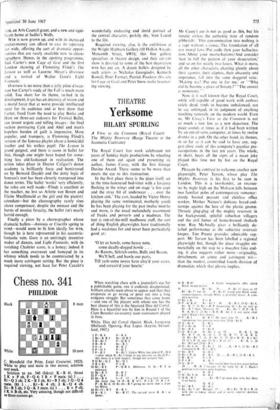West is best
BALLET CLEMENT CRISP
With ten years of blood, sweat, tears and glorious persistence behind it, Western Theatre Ballet is currently celebrating at Sadler's Wells, and rightly so. The miracle is not" that this company has kept afloat for a decade, sometimes nearly sinking but contriving to bob up again—though that is phenomenal enough—but rather that it has kept true to the original intentions of its founders, Eliza- beth West and Peter Darrell: the Theattt is as important as the Ballet to wrB, and let Its hope it always will be. This is a view that cansorne- times worry dance purists, who have noticed the choreography taking second place to theatre ideit, but it is the vital antidote to the swan- poisoning and elfin jollity that have had such a disagrous effect -on the provincial audiences amang whom WTB has worked so hard and so well. By showing ,ms that dancing can be part of the modern _theatre, that ballet can tackle theales that were .auithinkable tea years ago for .ballet companies;" and that these themes can be a living force in 'the development of ballet itself, writ has earned our gratitude and affec-
lion, an Arts Council grant, and a new and signi- ficant home at Sadler's Wells.
WTB is now grown up, and with its increased pocket-money can afford to cast its repertory net wide, offering the sort of dramatic oppor- tunities that are rarely available now to chore- ographers. Hence, in the opening programme, Jack Carter's new Cage of God and the first London showing of Flemming Flindt's The Lesson as well as Laverne Meyer's Overture and a revival of Walter Gore's Light Fantastic.
Overture is no more than a jolly piece d'occa- sion but Carter's study of the Fall is much more solid. Too short for its theme, rushed in its development, it yet has an intensity of vision and a moral force that at worst provide intellectual meat for its audience and at best show that Carter. freed from the need to play Burke and Hare on three-act cadavers for Festival Ballet, can invent urgent and telling images: the final section portraying Cain and Abel and man's hopeless burden of guilt is impressive. More popular, and trumpery, is Flemming Flindt's version of the Ionesco_playlet about a homicidal teacher and his witless pupil. The Lesson is grand guignol, and there is room in ballet for that, though one might have hoped for some- thing less old-fashioned in realisation. The action takes place in Doctor Caligari's dance academy (a brilliantly fusty and bemirrored set by Bernard Dayd4) and the dotty logic of lonesco's text has been cleverly transposed into dance terms. The ballet 'works' very efficiently, the roles are well made—Flindt is excellent a§ the- teacher, no less so Arlette van Boven and Elaine MacDonald as the girl and the pianist/ attendant—but the choreography rarely rises above competence; despite the menace and the bursts of maniac fercieity, the ballet isn't nearly horrid enough.
Finally a piece by a choreographer whose dramatic ballets—Antonia or Crucifix spring to mind—would seem to fit him ideally for WFB, though he is here represented in his eccentric- fantastic vein. Gore is an untiringly inventive maker of dances, and Light Fantastic, with its ravishing Chabrier score, is a honey; indeed it has something oversweet and honeyed in its whimsy which needs to be counteracted by a much more astringent setting. But the piece is required viewing, not least for Peter Cazalet's
wonderfully endearing and timid portrait of the central character, perkily shy, Stan Laurel to the life.
Required viewing, also, is the exhibition at the Wright Hepburn Gallery (10 Halkin Arcade. Motcomb Street, SW1); - this fine gallery specialises in theatre design, and their current show is devoted to some of the best decoration WTB has put on. A dozen ballets designed by such artists as Nicholas Georgiadis, Kenneth Rowell, Peter Farmer, Patrick Procktor (his sets for Cage of God) and Peter Snow make fascinat- ing viewing.











































 Previous page
Previous page